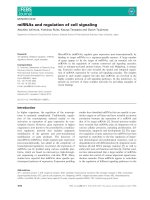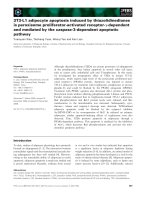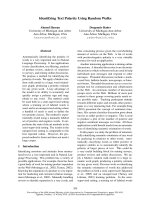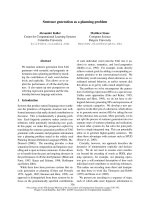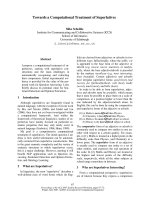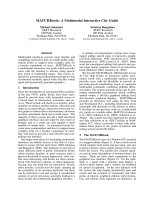Báo cáo khoa học: IFN-c enhances TRAIL-induced apoptosis through IRF-1 pptx
Bạn đang xem bản rút gọn của tài liệu. Xem và tải ngay bản đầy đủ của tài liệu tại đây (269.65 KB, 7 trang )
IFN-c enhances TRAIL-induced apoptosis through IRF-1
Sang-Youel Park
1
, Jae-Won Seol
1
, You-Jin Lee
1
, Jong-Hoo Cho
1
, Hyung-Sub Kang
1
, In-Shik Kim
1
,
Soo-Hyun Park
1
, Tae-Hyoung Kim
2
, John H. Yim
3
, Moonil Kim
3
, Timothy R. Billiar
3
and Dai-Wu Seol
3
1
Bio-Safety Research Institute, College of Veterinary Medicine, Chonbuk National University, Jeonju, Jeonbuk, South Korea;
2
Department of Biochemistry, Chosun University School of Medicine, Dong-Gu, Gwangju, South Korea;
3
Department of Surgery,
University of Pittsburgh School of Medicine, Pittsburgh, PA, USA
Tumor n ecrosis factor (TNF)-related apoptosis-inducing
ligand (TRAIL) is a member of the TNF family and a potent
inducer of apoptosis. TRAIL has been shown to effectively
limit tumor growth in vivo without detectable cytotoxic side-
effects. Interferon (IFN)-c often modulates the anticancer
activities of TNF family members including TRAIL. How-
ever, little is known about the mechanism. To explore the
mechanism, A549, HeLa, LNCaP, Hep3B and HepG2 cells
were pretreated with IFN-c, and then exposed to TRAIL.
IFN-c pretreatment augmented TRAIL-induced apoptosi s
in all these cell lines. A549 cells were selected and further
characterized for IFN-c action in TRAIL-induced apopto-
sis. Western blotting analyses revealed that IFN-c dramat-
ically increased the protein levels of interferon regulatory
factor (IRF)-1, but not TRAIL receptors (DR4 and DR5)
and pro-apoptotic (FADD a nd Bax) and anti-apoptotic
factors ( Bcl-2, Bcl-XL, cIAP-1, cIAP-2 and XIAP). T o elu-
cidate the functional r ole of I RF-1 in IFN- c-enhanced
TRAIL-induced apoptosis, IRF-1 was first overexpressed
by using an adenoviral v ector AdIRF-1. IRF-1 overexpres-
sion minimally increased apoptotic cell death, but signifi-
cantly enhanced apoptotic cell death induced by TRAIL
when infected cells were treated with TRAIL. In further
experiments using an antisense oligonucleotide, a specific
repression of IRF-1 e xpression abolished enhancer activity
of IFN-c for TRAIL-induced apoptosis. T herefore, our data
indicate that IFN-c enhances TRAIL-induced apoptosis
through IRF-1.
Keywords: a poptosis; IFN-c;IRF-1;TRAIL.
Apoptosis is a n active cell death proc ess that i s genetically
regulated. This process plays an important role in the
development and homeostasis of multicellular organisms
[1]. Among apoptosis-inducing proteins, the best character-
ized are the ligand-type cytokine molecules of the TNF
family. T NF famil y member proteins such as TNF-a,Fas
ligand and TRAIL are type II transmembrane molecules
that trigger the apoptotic signal cascade by ligating cognate
receptors displayed on the cell surface [2,3].
Although TRAIL is a T NF family member [4,5], it has
some notable differences when compared with TNF- a and
FasL. For example, unlike Fas, TRAIL receptors DR4 and
DR5 are widely expressed [4,5], thus most tissues and cell
types are potential targets to TRAIL. Furthermore, TRAIL
induces apoptosis in a wide variety of tumor cells but not in
most normal cells. Recent preclinical studies demonstrated
that repeated systemic administration of recombinant
TRAIL protein effectively limited tumor growth without
detectable toxicity [6,7]. Thus, considerable attention has
been paid to TRAIL as a promising therapeutic to treat
human cancers.
The transcription factor interferon regulatory factor
(IRF)-1 was identified as a regulator of the interferon
(IFN)-c system [8]. Accumulated evidence shows that
IRF-1 fun ctions as a tumor suppressor [9–17]. IRF-1
suppresses the transformed phenotype [9,14,15] and i s
essential for DNA-damage-induced apoptosis in mitogen-
activated T lymphocytes [11,12]. IFN-c has b een also
shown to sensitize cells to various apoptotic stimuli
including TNF family members [18–20]. Recently, several
studies demonstrated IFN-c and TNF synergism in
cancer cell apoptosis and necrosis [18,20,21] and recent
studies have also shown that IFN synergistically induced
TRAIL-mediated apoptosis [22–25]. H owever, little i s
known about the synergy or enhancing molecular mech-
anism of I FN-c on tumor cell apoptosis. Thus, w e
investigated the role and regulation mechanism of IFN-c
in T RAIL-induced apoptosis. In A549, HeLa, LNCaP,
Hep3B and HepG2 cells, IFN-c-pretreatment augmented
TRAIL-induced apoptosis. In A549 cells, IFN-c dramat-
ically increased t he protein l evels of IRF-1. Overexpres-
sion of IRF-1 protein by an adenoviral vector AdIRF-1
increased TRAIL-induced apoptosis upon expo sure of
infected cells to TRAIL treatment. IFN-c-enhanced
TRAIL-induced apoptosis was significantly blocked by
antisense oligonucleotide that specifically suppresses
IRF-1 protein expression. Therefore, our data indicate
that IRF-1 is a key component in the IFN-c enhance-
ment mechanism in TRAIL-induced apoptosis.
Correspondence to D W. Seol, BST W1513 Department of Surgery,
University of Pittsburgh School of Medicine, Pittsburgh, PA 15261,
USA. Fax: +1 412 6241172, Tel.: +1 412 6246704,
2
E-mail:
Abbreviations: IFN, interferon; IRF, interferon regulatory factor;
NK, natural killer; TRAIL, TNF-related apoptosis-inducing ligand;
TNF, tumor necrosis factor.
(Received 22 April 2004, revised 1 September 2004,
accepted 7 September 2004)
Eur. J. Biochem. 271, 4222–4228 (2004) Ó FEBS 2004 doi:10.1111/j.1432-1033.2004.04362.x
Materials and methods
Cell culture
A549 (a human lung carcinoma), HeLa (a human cervical
carcinoma), LNCaP (a human prostate cancer cell line),
Hep3B (a human hepatocellular carcinoma) and HepG2
(a human hepatocellular carcinoma) cells were obtained
from ATCC and maintained in suggested culture medium
supplemented w ith 10% (v/v) fetal bovine serum and
antibiotics (100 lgÆmL
)1
gentamycin and 100 lgÆmL
)1
penicillin/streptomycin).
Cell viability
Cells grow n in 12-wells were pretre ated with human IFN-c
(100 U ÆmL
)1
) (Roche Molecular Biochemicals, Mannheim,
Germany). After 12 h, recombinant human TRAIL protein
[26] was added to culture media directly and coincubated for
an additional 3 h. Cell viability w as determined by thecrystal
violet staining method as described [27], and cell m orphology
was photographed under the microscope. Briefly, cells were
stained for 10 min at room temperature w ith staining
solution [0.5% (v/v) crystal violet in 30% (v/v) ethanol and
3% (v/v) formaldehyde], washed four times with water,
and dried. Cells were lysed with 1% (w/v) SDS solution, and
measured at 550 nm. Cell v iability was calculate d from
relative dye intensity and compared with the controls.
Western blotting
To prepare whole cell lysates, cells were harvested, resus-
pended in lysis buffer [25 m
M
HEPES (pH 7.4), 100 m
M
NaCl, 1 m
M
EDTA, 5 m
M
MgCl
2
,0.1m
M
dithiothreitol,
and protease inhibitor mixture] and sonicated. Proteins were
separated on 12 or 15% (w/v) SDS gel and analyzed by
Western blotting as described pre viously [28,29]. DR4 (AAP-
420), DR5 (AAP-430), caspase-3 (AAP-103) and caspase-8
(AAP-118) were probed with a ntibody obtained from
Stressgen (Victoria, BC, Canada) and IRF-1 (sc-497) and
IRF-2 (sc-498) from Santa Cruz (Santa Cruz, CA, USA).
Adenoviral vectors
E1- and E3-deleted AdIRF-1 was constructed through
Cre-lox recombination as described previously [30]. Briefly,
cDNA for IRF-1 or EGFP, driven by the CMV promoter
and terminated by the SV40 poly(A) signal was inserted into
theshuttlevectorpAdloxtocreatepAdlox-IRF-1or
pAdlox-EGFP. Recombinant adenovirus was generated
by cotransfection of appropriately digest ed pAdlox-IRF-1
or pAdlox-EGFP and Y5 helper virus DNA into the Ad
packaging cell line CRE8 which expresses Cre recombinase.
Recombinant adenoviruses were propagated on 293 cells
and purified by cesium chloride density gradient centrifu-
gation and subsequent dialysis.
Adenoviral infection
A549 cells were plated in six- or 12-well plates, a nd
adenoviral infections were performed t he next day for 4 h
with virus diluted in Opti-MEM I (Gibco
3
, Grand Island,
NY, USA) to the desired multiplicity of infection (0–80).
The infected cells were washed three times with phosphate-
buffered s aline a nd maintained with the F-12K culture
medium. A fter 24 h, infected ce lls were e xposed to recom-
binant TRAIL protein for 3 h. Cell viability was determined
by the crystal violet staining method [28], and morphology
was photographed under the microscope. IRF-1 protein
expressio n in AdIRF-1-infected cells was confirmed by
Western blotting.
Transfection of oligonucleotides
A549 cells grown in six- or 12-well were transfected with
2 lg o f IRF-1 sense (S) or antisense (AS) phosphothioated
oligonucleotide (S, 5¢-GCATCTCGGGCATCTTTC-3¢;
AS, 5¢-GAAAGATGCCCGAGATGC-3 ¢) [ 31,32] using
GenePorter transfection reagent (Gene Therapy Systems
4
,
San Diego, C A, USA). After 6 h, the cells were exposed to
IFN-c for 12 h and coincubated with TRAIL protein for an
additional 3 h, then assayed for viability. For I RF-1
immunoblotting, t ransfected cells were tr eated with IFN-c
for 2 h before the cells were lysed .
Results
Enhancement of TRAIL-induced apoptosis by IFN-c
In some cell types, IFN-c induces cell death and has
antitumor activities [33–35]. IFN-c has also been shown
to increase susceptibility of target cells to Fas ligand- or
TNF-a-induced apoptosis [18,20,36]. Generally, combina-
tion therapies produce a better efficacy t han i ndividual
therapies in cancer treatment. We previou sly observed
that A549 cells (from human lung carcinoma) are
relatively resistant to TRAIL. Thus, we selected A549
cells as our experimental model to determine wh ether
IFN-c also enhances TRAIL-induced apoptosis. A549
cells were pretreated with IFN-c (100 UÆmL
)1
) for 12 h,
and then e xposed to recombinant TRAIL protein [26] for
an additional 3 h. The results of cell viability tests
showed that TRAIL alone induced 20% cell death after a
3-h incubation, but 12-h IFN-c pretreatment increased
TRAIL-induced cell death to more than 60% (Fig. 1A).
IFN-c treatment alone did not induce cell death in this
cell line. Cell death induced by TRAIL or TRAIL plus
INF-c was completely b locked by a pan-caspase inhib-
itor z-VAD-fmk o r a caspase-8 inhibitor z-IETD-fmk
(Fig. 1 B), indicating that observed cell death is apoptotic
cell death rather than necrotic cell death. Examination of
cell m orphology also supported enhancer activity of
IFN-c in TRAIL-induced apoptosis (Fig. 1C). Consis-
tently, more caspase-8 was activated by cotreatment with
IFN-c and TRAIL than by TRAIL a lone (Fig. 1D).
Caspase-3 activation was also observed t o increase only
slightly in response to treatment with IFN-c and TRAIL,
compared with that observed for TRAIL alone (Fig. 1D).
IFN-c was also observed to enhance TRAIL-induced
apoptosis in other cell lines such as HeLa (a cervical
carcinoma), LNCaP (a prostate cancer cell line), Hep3B
(a hepatocellular c arcinoma) and Hep G2 (a hepatoc ellular
carcinoma) (Fig. 1E), indicating that IFN-c acts in a bro ad
range of tissues to enhance TRAIL-induced apoptosis.
Ó FEBS 2004 IFN-c enhances TRAIL-induced apoptosis
1
(Eur. J. Biochem. 271) 4223
Stimulation of IRF-1 protein expression by IFN-c
Generally, extra-cellular stimuli activate intracellular sign-
aling cascades by stimulating the factors involved in the
signaling cascades. Recently, we reported that TRAIL
death-inducing signal transmits from activated receptors
through c aspase-8, Bid, released cytochrome c , and execu-
tioner caspases including caspase-3 [28]. It was suggested
that modulation of any of these signaling components
regulate TRAIL-induced apoptosis. Thus, we investigated
whether IFN-c treatment regulates expression of these
molecules. A549 cells were pretreated with IFN-c,further
exposed to TRAIL and subjected to Western blotting
analyses. IFN-c or IFN- c plus TRAIL treatment dramat-
ically increased the protein levels of IRF-1, but not TRAIL
receptors (DR4 and DR5) and IRF-2 ( Fig. 2). Treatment
with TRAIL a lone did not affect IRF-1 expression,
indicating that the increase o f IRF-1 by IFN-c plus TRAIL
is mainly controlled by IFN-c. In parallel, we also examined
other signaling components known to a ffect mainstream
signaling of TRAIL-induced cell death. S imilar to T RAIL
receptors, IFN-c treatment did not change the expression
0
30
60
90
120
A
B
D
E
C
IFN-γ
TRAIL
IFN-γ
TRAIL
IFN-γ
TRAIL
IFN-γ
TRAIL
+
––
–
–
–
––
––
–
–
–
––
–
+
+
+
+
++
+
0
30
60
90
120
++
+
None z-VAD-fmk z-IETD-fmk
LNCaPHeLa Hep3B HepG2
0
30
60
90
120
Control
TRAIL
IFN- γ
IFN- γ +TRAIL
Procaspase-3
Procaspase 8
Active form
Active form
+
++
+
Fig. 1. Effect of IFN-c on TRAIL-induced apoptosis. (A) A549 cells plated in 12-well were pretreated with IFN-c (100 UÆmL
)1
) for 12 h, and then
coincubated with or witho ut reco mbinant TRAIL pro tein (100 ngÆmL
)1
) for an additional 3 h. Cell viability was determined by crystal violet
staining method. Viability of control cells was set at 100%, and viability relative to the control was presented. The experiments were performed at
triplicate, at least twice. The bar indicates standard error. (B) A549 cells plated in 12-well were pretreated with IFN-c (100 UÆmL
)1
)for11hand
incubated with z-VAD-fmk (100 l
M
) or z-IETD-fmk (100 l
M
) for an additional 1 h, and then coincubated with or without recombinant TRAIL
protein (100 ngÆmL
)1
) for 3 h. Cell viability was determined as described in (A). (C) Cell morphology under the conditions as described in (A) was
photographed. (D) A549 cells were pretreated with IFN-c (100 UÆmL
)1
) for 12 h, and then coincubated with or without recombinant TRAIL
protein (100 ngÆmL
)1
) for 1 h. Whole cell lysates were prepared as described in Materials and methods and subjected to Western blotting analysis.
(E) Cell viability of HeLa, LNCaP, Hep3B and HepG2 cells in response to media (control), IFN-c, TRAIL, or TRAIL plus IFN-c was determined
as described in (A).
4224 S Y. Park et al. (Eur. J. Biochem. 271) Ó FEBS 2004
levels of other p ro-apoptotic proteins such as FADD and
Bax (data n ot shown) and anti-apoptotic proteins such as
Bcl-2, Bcl-XL, cIAP-1, cIAP-2 and XIAP (Fig. 2B). Our
data suggest that IRF-1, a nuclear transcription factor, may
play a role in mediating enhancer effects of IFN-c in
TRAIL-induced A549 cell apoptosis.
Enhancement of TRAIL-induced apoptosis by
overexpression of IRF-1 protein
IRF-1 has been shown to suppress tumor growth in vivo
[10,17,37]. Thus, we h ypothesized that IRF-1 m ay directly
mediate the enhancer effects of IFN-c in TRAIL-induced
apoptosis. T o examine this possibility, we first over-
expressed IRF-1 by taking advantage of AdIRF-1, an
adenoviral vector expressing IRF-1. AdIRF-1 infected cells
showed a minimal increase in baseline cell death throughout
the experimental settings, whereas additional TRAIL treat-
ment significantly increased cell death in AdIRF-1-infected
cells (Fig. 3A). In contrast, AdEGFP infection did not
significantly change cell d eath in response to T RAIL.
Examination of cell morphology also supported the func-
tional role of A dIRF-1 in TRAIL-induced cel l death
(Fig. 3 B). To confirm IRF-1 protein expression by
AdIRF-1 infection, infected cells were subjected to Western
blotting analysis (Fig. 3C). I RF-1 protein was highly
expressed by AdIRF-1 infection in contrast to the AdEGFP
A
TRAIL
IFN-γ
DR4
DR5
IRF-1
IRF-2
+
++
+
Bcl-2
Bcl-XL
XIAP
cIAP-1
cIAP-2
TRAIL
IFN-γ
B
+
++
+
–
––
––
–
––
Fig. 2. Western blot analysis showing expression pattern of various
proteins in A549 cells exposed to IFN-c and TRAIL protein. A549 cells
were pretreated with IFN-c (100 UÆmL
)1
) for 12 h, and then coincu-
bated with or without recombinant TRAIL protein (100 ngÆmL
)1
)for
1 h. Whole cell lysates were prepared as de scribed in M aterials and
methods and subjected to Western blotting analysis.
B
M
OI
+TRAIL -TRAIL
AdIRF-1
20 80
A
AdIRF-1
AdEGFP
10 20 8040
0
25
50
75
100
80
-TRAIL +TRAIL
MOI
0
C
IRF-1
AdEGFP AdIRF-1
MOI 80 10 20 40 80
0
NS
Fig. 3. Effect of IRF-1 overexpression on TRAIL-induced apoptosis.
(A) A549 cells were infected with AdEGFP or AdIRF-1 for 4 h,
washed, and further cultured. Twenty-fo ur hours later, recombinant
TRAIL protein (100 ngÆmL
)1
) was added to culture medium and
incubated for 3 h. Cell viability w as determined by crystal violet
staining method. Viability of control cells was set at 100%, and
viability relative to the control was presented. The experiments were
performed at triplicate, at least twice. The bar indicates standard error.
(B) Cell morpholo gy under t he con ditions as d escribed i n (A) was
photographed. ( C) A549 cells we re i nfec ted w ith AdEGFP or A dIRF-1
for 4 h, washed, and further cultured. Twenty-four hours later, whole
cell lysates were prepared and subjected to Western blotting analysis
for IRF-1 expression. The NS indicates a nonspecific protein band that
was used to ensure equal protein loading.
Ó FEBS 2004 IFN-c enhances TRAIL-induced apoptosis
1
(Eur. J. Biochem. 271) 4225
control vector that showed no expression. This result
indicates that TRAIL-induced cell death is enh anced by
IRF-1.
Blockade of IFN-c-enhancement by IRF-1 suppression
in TRAIL-induced apoptosis
Although o verexpression of IRF-1 e nhanced TRAIL-
induced apoptosis, the role of IRF-1 in mediating IFN-c
enhancer activity in TRAIL-induced apoptosis is unclear.
Therefore, to address this question, we used an antisense
oligonucleotide that specifically suppresses IRF-1 protein
expression. A549 cells were transfected with a sense or
antisense oligonucleotide, and pretreated with IFN-c for
12 h, followed by TRAIL treatment for an additional
3 h . The sense oligonucleotide d id not affect TRAIL-
induced apoptosis in IFN-c-pretreated cells. However, the
antisense oligonucleotide almost completely p rotected
IFN-c-pretreated cells from TRAIL-induced cell death
(Fig. 4 A). Western blotting analysis revealed that IRF-1
protein expression was effectively suppressed by the
antisense oligonucleotide (Fig. 4B). Therefore, our data
demonstrate that IFN-c enhances TRAIL-induced apop-
tosis through IRF-1, and IRF-1 is a key mediator in
transmitting IF N-c enhancer signal in TRAIL-induced
cell death.
Discussion
We have demonstrated that IRF-1 directly regulates IFN-c
enhancement of TRAIL-induced apoptosis. Overexpression
of IRF-1 protein by AdIRF-1 enhanced TRAIL-induced
apoptosis, and a specific suppression of IRF-1 protein
expression by an antisense oligonucleotide prevented
enhancer activity of IFN-c in TRAIL-induced apoptosis.
This is the first indication that IFN-c enhancement of
TRAIL-induced apoptosis is regulated by IRF-1 protein.
Other studies have demonstrated that IFN-c also synergizes
Fas- and TNF receptor-mediated tumor cell d eath [10,18–
20,36]. Thus, IFN-c commonly enhances cell death induced
by the three major death-inducing ligands of the TNF
family. These results indicate that IFN-c regulation of death
signaling pathway is commonly involved in TRAIL-, Fas
ligand- and TNF-a-induced cell death. However, it is poorly
understood how IRF-1 regulates IFN-c enhancement of
apoptosis induced by these ligand molecules. As suggested
[10,18–20,36], IFN-c or IFN- c-induced IRF-1 may inhibit
activation of the transcription factor nuclear factor-kappa B
which a ntagonizes activation of various apoptosis-inducing
signals. IRF-1 was shown to play a c ritical role in DNA-
damage-induced apoptosis in mature T lymphocytes [11,12],
and regulate a cycline-dependent kinase inhibitor p 21 and
lysyl
5
oxidase genes [13,38]. Thus, it is tempting to examine if
p21-driven c ell cycle arrest is involved in this enhancer
mechanism. In addition, as we reported recently [39], IRF-1
may regulate expression of cellular factors induced by
TRAIL an d enhance TRAIL-induced apoptosis. However,
which cellular factors are the targe ts of IRF-1 has yet to be
determined. The protein level of FADD, Bax, Bcl-2, Bcl-
XL, cIAP-1, cIAP-2 and XIAP that are known to act in
death signaling pathways in TRAIL-induced apoptosis did
not change significantly in response to IFN-c. Thus, other
cellular factors involved in death signaling pathways
activated by TRAIL are now under investigation.
We do not rule out the possibility that IRF-1 may
transmit enhancer activity of INF-c via a protein–protein
interaction in TRAIL-induced apoptosis. A s well docu-
mented, p53, a tumor suppressor and transcription f actor,
modulates cell physiology not only b y interacting with
various cellular factors [40,41], but also by regulating
transcription of the target genes [42–44]. Thus, this possi-
bility is also under investigation in this laboratory.
Importantly, a recent study demonstrated that TRAIL
plays an essential role in the natural killer (NK) cell-
mediated and IFN-c-dependent tumor surveillance in vivo
[45,46]. IFN-c was shown to modulate TRAIL-mediated
tumor s urveillance, not only by r egulating TRAIL expres-
sion on NK cells, but also by sen sitizing tumor cells to
TRAIL-induced cytotoxicity. Although the mechanism by
which IFN-c sensitizes tumor cells to TRAIL-induced
apoptosis was not elucidated in the report, our data suggest
an active role of IRF-1 i n t he mechanism. Thus, our data
sheds light on better un derstanding an in vivo tumor
A
0
25
50
75
100
T
RAIL
Sense Antisense
IFN-γ
+
–
–––
–
+
++
+
+
B
Control Sense Antisense
IFN-γ
IRF-1
NS
+++
Cell Viability
Fig. 4. Effect of o ligonucleotides on IFN-c enhanced TRAIL-induced
apoptosis. (A) Six hours after transfection of IRF-1 sense or antisense
oligonucleotide, A549 cells were pretreated with IFN-c (100 UÆmL
)1
)
for 12 h, and further exp osed to TRAIL protein (0 or 100 ngÆmL
)1
)for
3 h. Cell viability w as determined by crystal violet staining method.
Viability of control cells was set at 100%, and viability relative to the
control was presented. The experiments were perfo rmed at triplic ate,
at least twice. T he b ar indicates standard erro r. ( B) S ix hours a fter
transfection of IRF-1 sense or antisense oligonucleotide, A549 c ells
were pretreated with IFN-c (100 UÆmL
)1
) f or 2 h. Whole cell lysates
were prepared and subjected to Western blotting analysis for IRF-1
expression. The NS indicates a nonspecific protein band that was used
to ensure equal protein loading.
4226 S Y. Park et al. (Eur. J. Biochem. 271) Ó FEBS 2004
surveillance mechanism [45,46]. This result and our data
also suggest a possible c ombination therapy o f IFN-c and
TRAIL for cancer treatment in humans. Because combi-
nation therapies produce a better prognosis than individu al
therapies in cancer treatment, the combination of IFN-c
and TRAIL may b e a very promising a nticancer therapy to
treat human cancers. Furthermore, our data also suggest
that in addition to IFN-c, IRF-1 may combine with TRAIL
protein to induce effective tumor cell death.
Acknowledgements
This work was supported by the Competitive Medical Research Fund,
the Department of D efense grant D AMD17-01-1-0607 and Vascular
System Research Grant of KOSEF (D W.S.), and National Institutes
of Health grants GM4410 0 a nd GM53789 (T.R.B.), and Bio-Safety
Research Institute grant, Chonbuk National University in 2004
(S Y.P.).
References
1. Nagata, S. (1997) Apoptosis by death factor. Cell 88, 355–365.
2. Cha, S.S., Kim, M.S., Choi, Y.H., Sung, B.J., Shin, N.K., Shin,
H.C., Sung, Y.C. & Oh, B.H. (1999) 2.8 A
˚
resolution crystal
structure of hum an TRAIL, a c ytokine with se lective a ntitumor
activity. Immunity 11, 253–261.
3. Hymowitz, S.G., Christinger, H.W., Fuh, G., Ultsch, M.,
O’Connell, M., K elley, R.F., Ashkenazi, A. & de Vos, A.M. (1999)
Triggering cell death: the crystal structure of Apo2L/TRAIL in a
complex with death receptor 5. Mol. Cell 4, 563–571.
4. Wiley, S.R., Schooley, K., Smolak, P.J., Din, W.S., Huang, C.P.,
Nicholl, J.K., Sutherland, G.R., Smith, T.D., Rauch, C. & Smith,
C.A. (1995) Identification and characterization of a new m ember
of the TNF family that induces apoptosis. Immunity 3, 673–682.
5. Pitti, R.M., Marsters, S.A., Ruppert, S., Don ahue, C.J., Moore,
A. & Ashkenazi, A. (1996) Induction of apoptosis by Apo-2
ligand, a new member of the t umor necrosis factor cytokine
family. J. Biol. Chem. 271, 12687–12690.
6. Griffith, T.S., Anderson, R.D., Davidson, B.L., Williams, R.D. &
Ratliff, T.L. (2000) Adenoviral-mediated transfer of the TNF-
related apoptosis-inducing ligand/Apo-2 ligand gene induces
tumor cell apoptosis. J. Immunol. 165, 2 886–2894.
7. Walczak, H., M iller, R.E., Ariail, K., Gliniak, B., Griffith, T.S.,
Kubin, M., Chin, W., Jones, J., Woodward, A., Le, T., Smith, C.,
Smolak, P., Go odwin, R.G., Rauch, C.T., Schuh, J.C. & Lync h,
D.H. (1999) Tumoricidal activity of tumor necrosis factor-related
apoptosis- inducing ligand in vivo. Nat. Med. 5, 157–163.
8. Taniguchi, T., Fujita, T., Yamada, G., Hatakeyama, M., Ishizaka,
E., Miyamoto, M., Maruyama, M. & S hibuya, H. (1988) Reg-
ulation of cytokine gene expression: gene activation in type I IFN
and IL-2 systems. Princess Takamatsu Symp. 19, 279–286.
9. Harada, H., Kitagawa, M., Tanaka, N., Yamamoto, H., Harada,
K., Ishihara, M. & Taniguchi, T. (1993) Anti-oncogenic and
oncogenic potentials of interferon regulatory factors-1 and -2.
Science 259, 971–974.
10. Park, J.S., Kim, E.J., Kwon, H.J., Hwang, E.S., Namkoong, S.E.
& Um, S.J. (2000) In activation of interferon regulatory factor-1
tumor suppressor protein by HPV E 7 oncoprotein: implication for
the E7-mediated immune evasion m echanism in cervical carcino-
genesis. J. Biol. Chem. 275, 6764–6769.
11. Tamura, T., Ishihara, M., Lamphier, M.S., Tanaka, N., Oishi, I.,
Aizawa, S., Matsuyama, T., Mak, T.W., Taki, S. & Taniguchi, T.
(1995) An IRF-1-de pendent p athway of DNA damage-induced
apoptosis in mitogen-activated T lymphocytes. Nature 376,
596–599.
12. Tamura, T., Ishihara, M., Lamphier, M.S., Tanaka, N., Oishi, I.,
Aizawa, S., Matsuyama, T., Mak, T.W., Taki, S. & Taniguchi, T.
(1997) DNA damage-induced apoptosis and Ice gene induction in
mitogenically activated T ly mphocytes require IRF-1. Leukemia
11 (Suppl. 3), 439–440.
13. Tan, R.S., Taniguchi, T. & Harada, H. (1996) Identification of the
lysyl oxidase gene as target of the antioncogenic transcription
factor, IRF-1, a nd its possible role in tumor suppression. Cancer
Res. 56, 2417–2421.
14. Tanaka,N.,Ishihara,M.,Kitagawa,M.,Harada,H.,Kimura,T.,
Matsuyama, T., La mphie r, M.S., Aiza wa, S., Mak, T.W. &
Taniguchi, T. (1994) Cellular commitment to oncogene-induced
transformation or apoptosis is dependent on the transcription
factor IRF-1. Cell 77, 829–839.
15. Tanaka, N., Ish ihara, M. & Taniguchi, T. (1994) Suppression o f
c-myc or fosB-induced c ell transformation b y the tran scription
factor IRF-1. Cancer Lett. 83, 191–196.
16. Tanaka, N., Ishihara, M., Lamphier, M.S., Nozawa, H.,
Matsuyama, T., Mak, T.W., A izawa, S., Tokino, T., Oren, M.
& Taniguchi, T. (1996) Cooperation of the tumour suppressors
IRF-1 and p53 i n response t o DNA damage. Nature 382, 816–
818.
17. Yim,J.H.,Wu,S.J.,Casey,M.J.,Norton,J.A.&Doherty,G.M.
(1997) IFN regulatory factor-1 g ene transfer i nto an aggressive,
nonimmunogenic sarcoma suppresses the malignant phenotype
and enhances immunogenicity in syngeneic mice. J. Immunol. 158,
1284–1292.
18. Suk, K., Kim, S., Kim, Y.H., Kim, K.A., Chang, I., Yagita, H.,
Shong, M. & Lee, M.S. (2001) IFN-gamma/TNF-alpha synergism
as the final effector in autoimmune diabetes: a key role f or STAT1/
IFN regulatory factor-1 path way in pan creatic be ta cell de ath.
J. Immunol. 166, 4481–4489.
19. Shin, E.C., Shin, W.C., Choi, Y., Kim, H., Park, J.H. & Kim, S.J.
(2001) Effect of interferon-gamma on the susceptibility to Fas
(CD95/APO-1)-mediated cell death in human hepatoma cells.
Cancer Immunol. Immunother. 50, 23–30.
20. Sasagawa, T., Hlaing, M. & Akaike, T. (2000) Synergistic induc-
tion of apoptosis in murine hepatoma Hepa1–6 cells by IFN-
gamma and TNF-alpha. Biochem. Biop hys. R es. C ommun. 272,
674–680.
21. Suk, K., Kim, Y.H., Chang, I., Kim, J.Y., Choi, Y.H., Lee, K.Y.
& Lee, M.S. (2001) IFNalpha sensitizes ME-180 human cervical
cancer cells t o TN Falpha-induced apoptosis by i nhibiting c yto-
protective NF-kappaB activation. FEBS Lett. 495, 66–70.
22. Yang, X., Merchant, M.S., Romero, M.E., Tsokos, M., Wexler,
L.H., Kontny, U., Mackall, C.L. & Thiele, C.J. (2003) Induction
of caspase 8 by interferon gamma renders some ne uroblasto ma
(NB) cells sensitive to tumor necrosis factor-related apoptosis-
inducing ligand (TRAIL) but reveals that a lack of membrane
TR1/TR2 a lso contributes to T R AIL r esistance in NB. Cancer
Res. 63, 1122–1129.
23. Shin, E.C., Ahn, J.M., Kim, C.H., Choi, Y., Ahn, Y.S., Kim, H.,
Kim, S.J. & Park, J.H. (2001) IFN-gamma induces cell death in
human hepatoma cells through a TRAIL/death receptor-mediated
apoptotic pathway. Int. J. Cancer 93, 262–268.
24. Kim , K.B., Choi, Y.H., Kim, I.K., Chung, C.W., Kim, B.J., Park,
Y.M. & Jung, Y.K. (2002) Potentiation of Fas- and TRAIL-
mediated apoptosis by IFN-gamma in A549 lung epithelial cells:
enhancemen t of caspase-8 expression t hrough IFN-response
element. Cytokine 20, 283–288.
25. Kumar-Sinh a, C., Varambally, S., Sreekumar, A. & Chinnaiyan,
A.M. (2002) Molecular cross-talk between th e TRAIL and inter-
feron signaling pathways. J. Biol. Chem. 277, 575–585.
26. Seol, D.W. & Billiar, T.R. (2000) Cysteine 230 modulates tumor
necrosis factor-related apoptosis-inducing ligand a ctivity. Cancer
Res. 60, 3152–3154.
Ó FEBS 2004 IFN-c enhances TRAIL-induced apoptosis
1
(Eur. J. Biochem. 271) 4227
27. Seol, D.W. & Billiar, T.R. (1999) A caspase-9 variant missing the
catalytic site is an endogenous inhibitor of apoptosis. J. Biol.
Chem. 274, 2072–2076.
28. Seol, D.W., Li, J., Seol, M.H., Park, S.Y., Talanian, R.V. &
Billiar, T.R. (2001) Signaling events triggered by tumor necrosis
factor-related apoptosis-inducing ligand (TRAIL): caspase-8 is
required for TRAIL-induced apoptosis. Cancer Res. 61, 1138–
1143.
29. Park, S.Y., Billiar, T.R. & Seol, D.W. (2002) Hypoxia inhibition
of apoptosis induced by tumor necrosis factor- related apoptosis-
inducing ligand (TRAIL). Biochem. Biophys. Res. Commun. 291,
150–153.
30. Hardy, S., K itamura, M., H arris-Stansil, T., Dai, Y. & Phipps,
M.L. (1997) Construction of adenovirus vectors through Cre-lox
recombination. J. Virol. 71, 1842–1849.
31. Horiuchi, M., K oike, G., Yamada, T., Mukoyama, M., Nakaj-
ima, M. & Dzau, V.J. (1995) The growth-dependent expression of
angiotensin II type 2 receptor is regulated by transcription factors
interferon regulatory factor-1 and -2. J. Biol. Chem. 270, 20225–
20230.
32. Horiuchi, M., Yamada, H., Akishita, M., Ito, M., Tamura, K. &
Dzau, V.J. (1999) Interferon regulatory factors regulate inter-
leukin-1beta-converting enzyme expression and apoptosis in vas-
cular smooth muscle cells. Hypertension 33, 162–166.
33. Nunokawa, Y . & Ta naka, S. ( 1992) Interferon-gamma inhibits
proliferation of r at vascular s mooth muscle cells by nitric oxide
generation. Biochem. Biophys. Res. Commun. 188, 409–415.
34. Kirkwood , J.M. & Ernstoff, M.S. (1990) Role of interferons in the
therapy of melanoma. J. I n vest Dermatol. 95, 180S–184S.
35. Kirkwood, J .M., Ernstoff, M.S., Trautman, T., Hebert, G.,
Nishida, Y., Davis, C.A., Balzer, J., Reich, S., Schindler, J. &
Rudnick, S.A. (1990) In vivo biological response to recombinant
interferon-gamma during a phase I dose–response trial in patients
with metastatic melanoma. J. Clin. Oncol. 8, 1070–1082.
36. Fish, S.M., Proujansky, R. & Reenstra, W .W. (1999) Synergistic
effects of interferon gamma and t umour necrosis factor alpha on
T84 cell function. Gut 45, 191–198.
37. Zhou, Y., Wang, S., Gobl, A. & Oberg, K. (2000) The interferon-
alpha regulation of interferon regulatory factor 1 (IRF-1) and
IRF-2 has therapeutic implications in carcinoid tumors. Ann.
Oncol. 11, 707–714.
38. Tanaka, K., Oshimura, M., Kikuchi, R., Seki, M., Hayashi, T. &
Miyaki, M. (1991) Suppression of tumorigenicity in human colon
carcinoma c ells by introduction of normal ch romosome 5 or 18.
Nature 349, 3 40–342.
39. Park, S.Y., Billiar, T.R. & Seol, D.W. (2002) IFN-c inhibition of
TRAIL-induced IAP-2 upregulation, a possible mechanism of
IFN-c-enh anced TRAIL-induced apoptosis. Biochem. Biophys.
Res. Commun. 291, 233–236.
40. Sala, A., Casella, I., Grasso, L., Bellon, T., Reed, J.C., Miyashita,
T. & Peschle, C . (1996) Apoptotic response to o ncogenic stimuli:
cooperative and antagonistic interactions between c-myb and the
growth suppressor p53. Cancer Res. 56, 1991–1996.
41. Sorensen, T.S., Girling, R., Lee, C.W., Gannon, J., Bandara, L.R.
& La Thangue, N.B. (1996) Functional interaction between DP-1
and p53. Mol. Cell. Biol. 16, 5888–5895.
42. Ball, K.L. (1997) p21: structure and functions associated with
cyclin-CDK binding. Prog. Cell Cycle Res. 3, 125–134.
43. Bokoch, G.M., Wang, Y., Bohl, B.P., Sells, M.A., Quilliam, L.A.
& Knaus, U.G. (1996) Interaction of the Nck adapter protein with
p21-activated kinase ( PAK1). J. Biol. Chem. 271, 25746–25749.
44. Somasundaram, K . & El-Deiry, W.S. (1997) Inhibition of p53-
mediated transactivatio n and cell cycle arrest by E 1A through its
p300/CBP-interacting region. Oncogene 14, 1047–1057.
45. Smyt h, M.J., C retney, E ., T akeda, K ., Wiltrout, R .H., Sedger,
L.M., Kayagaki, N., Yagita, H. & Okumura, K. (2001) Tumor
necrosis factor-relat ed ap optosis-in ducing ligan d (TR AIL) con-
tributes to interferon gamma-dependent natural killer cell pro-
tection from tumor metastasis. J. Exp. Med. 193, 661–670.
46. Takeda, K., Smyth, M.J., Cretney, E., Hayakawa, Y., Kayag-
aki, N., Yagita, H. & Okumura, K. (2002) Critical role for
tumor necrosis factor-related apoptosis-inducing ligand in
immune surveillance against tumor d evelopment. J. Exp. Med.
195, 161–169.
4228 S Y. Park et al. (Eur. J. Biochem. 271) Ó FEBS 2004
